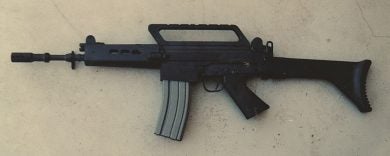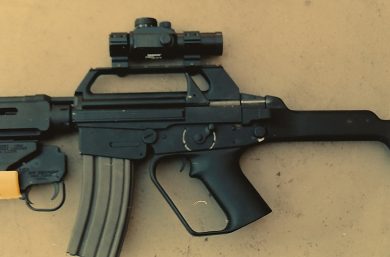In 1997, while Brazilian Army Captain (later, Lieutenant-Colonel) Paulo Augusto Capetti Porto was working at IMBEL’s Fábrica de Itajubá as head of the R&D Office, several interesting ideas materialized into a series of prototypes generally designated as FIL-97 (Fuzil Imbel Leve, Light Imbel Rifle) with 437mm barrels and FILC-97 (Fuzil Imbel Leve Curto, Short Light Imbel Rifle), for the shorter carbine-type variants with variable length barrels. This family of guns was merely intended to analyze different construction materials (polymers and light alloys) and ergonomic variations for possible use in future weapons, in what might be called concept ideas studies, if you wish. It should be recalled that they were all gas-operated and featured a rotary bolt breech locking system similar to the MD97 model then in production. Here’s a selection of some of the guns that emerged from that extremely creative period.
The earliest selective-fire FIL-97, while keeping some well-known FAL components (e.g. pistol grip/trigger assembly and handguard), introduced a new synthetic foldable stock and a long Picatinny rail added to the top of the gun, which kept the original iron sights.

This initial FIL-97 experimental rifle is shown with its characteristic polymer stock flat-folded to the right and with two synthetic magazines in addition to a standard aluminum piece fitted in weapon.

A virtually unchanged FAL handguard was used in the first FIL-97, whose STANAG-compatible 30-round magazine was a polymer unit experimentally made in Brazil.

Author and the same prototype at the Fábrica de Itajubá range in May, 1997, a rare occasion in which the rifle was made available for an “outsider” to fire. (Photo credit: Alexander Olive)

Alex Olive changed camera for rifle and tried the FIL-97 performance at full auto, which dad was able to catch on b&w film.
More radical changes were found in a FILC-97 carbine variant of the same period. Although presenting a similar polymer folding stock, a redesigned handguard of the same material was fitted and, also, a rearward-folding fore grip. In addition to that, the gun featured an elevated metal structure to accept optional optical sights, but the standard iron sights could still be used all the time thanks to opening that existed on the front and rear ends of the, well, “carry handle”. Another distinguishing characteristic of that carbine was the pistol grip design that incorporated a full-size trigger guard that protected all the fingers of the firing hand. A rifle (435mm barrel) variant with a similar configuration was also completed.

Although featuring a similar polymer folding stock as the early FIL-97, the FILC-97 carbine (top) incorporated several design changes in the ergonomics department.

The combination of the inclined “carry handle” and the full-length trigger guard gave the FILC-97 a smart look, in author’s belief. (Photo credit: Alexander Olive)

This close-up view shows the openings in the elevated railed structure that allowed constant use of the carbine’s iron sights (flip-type aperture rear sight, front post).

The same gun with the forward support grip extended might prove practical for close-in, Hollywood-style combat. (Photo credit: Alexander Olive)

The FILC-97 carbine test specimen, plus an Aimpoint red dot sight, with the stock folded and the forward grip extended. Some FAL items (fold-flat cocking handle and fire selector) may be spotted. Note translucent synthetic magazine.

A longer-barrel rifle variant (FIL-97) with the same foldable stock and forward-inclined sight support is seen here. Attachment point under the forward end of handguard might have been for a folding bipod.

Another FILC-97 variation, shown here, featured a slightly different handguard and a vertical cocking handle on the left side, which could also be reached through the “carry handle”.

Another view of the same carbine, stock folded.

This closer look shows the unusual cocking handle in the raised position, but which could also be turned full to the left. Note fire selector positions: “Safe”, top; “Repetition”, down; “Auto”, full forward.

One more “shorty” FILC-97 prototype with a differently-configured foldable stock, while using the same raised structure for add-on sights. Note that a FAL pistol grip and trigger group are there, as well as the fold-flat cocking piece.

The same prototype with the stock folded. The short handguard is somewhat reminiscent of the FAL’s.

A better view of the gun’s FAL stuff: fold-flat cocking handle, pistol grip, trigger group, and fire selector (“S”, “R”, and “A”).

The previously-described FILC-97carbine is seen here with still another FIL-97 rifle variant, which mixes the pistol grip/trigger guard unit used in other prototypes with a re-shaped folding stock and “carry handle”. And, why not add an under-barrel grenade launcher?

Looking closer at this FIL-97, it may be noticed that it also uses a vertical cocking handle (though larger than the previously shown model), and that the fire selector has an extra (3-round burst) position. The red-dot sight is a Tasco Propoint.

This is just a poster showing how creative Captain Capetti’s team was in 1997. First time ever shown on line by TFB!
 Your Privacy Choices
Your Privacy Choices